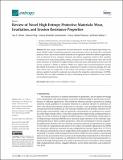| dc.contributor.author | Feltrin, Ana C. | |
| dc.contributor.author | Xing, Qiuwei | |
| dc.contributor.author | Akinwekomi, Akeem Damilola | |
| dc.contributor.author | Waseem, Owais Ahmed | |
| dc.contributor.author | Akhtar, Farid | |
| dc.date.accessioned | 2023-01-06T14:05:43Z | |
| dc.date.available | 2023-01-06T14:05:43Z | |
| dc.date.issued | 2022-12-30 | |
| dc.identifier.uri | https://hdl.handle.net/1721.1/146993 | |
| dc.description.abstract | By their unique compositions and microstructures, recently developed high-entropy materials (HEMs) exhibit outstanding properties and performance above the threshold of traditional materials. Wear- and erosion-resistant materials are of significant interest for different applications, such as industrial devices, aerospace materials, and military equipment, related to their capability to tolerate heavy loads during sliding, rolling, or impact events. The high-entropy effect and crystal lattice distortion are attributed to higher hardness and yield stress, promoting increased wear and erosion resistance in HEMs. In addition, HEMs have higher defect formation/migration energies that inhibit the formation of defect clusters, making them resistant to structural damage after radiation. Hence, they are sought after in the nuclear and aerospace industries. The concept of high-entropy, applied to protective materials, has enhanced the properties and performance of HEMs. Therefore, they are viable candidates for today’s demanding protective materials for wear, erosion, and irradiation applications. | en_US |
| dc.publisher | Multidisciplinary Digital Publishing Institute | en_US |
| dc.relation.isversionof | http://dx.doi.org/10.3390/e25010073 | en_US |
| dc.rights | Creative Commons Attribution | en_US |
| dc.rights.uri | https://creativecommons.org/licenses/by/4.0/ | en_US |
| dc.source | Multidisciplinary Digital Publishing Institute | en_US |
| dc.title | Review of Novel High-Entropy Protective Materials: Wear, Irradiation, and Erosion Resistance Properties | en_US |
| dc.type | Article | en_US |
| dc.identifier.citation | Entropy 25 (1): 73 (2023) | en_US |
| dc.contributor.department | Massachusetts Institute of Technology. Plasma Science and Fusion Center | |
| dc.identifier.mitlicense | PUBLISHER_CC | |
| dc.eprint.version | Final published version | en_US |
| dc.type.uri | http://purl.org/eprint/type/JournalArticle | en_US |
| eprint.status | http://purl.org/eprint/status/PeerReviewed | en_US |
| dc.date.updated | 2023-01-06T13:52:15Z | |
| dspace.date.submission | 2023-01-06T13:52:15Z | |
| mit.license | PUBLISHER_CC | |
| mit.metadata.status | Authority Work and Publication Information Needed | en_US |
